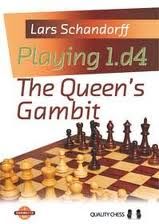Playing 1.d4 — The Queens Gambit
Lars Schandorff

A while ago I reviewed John Watsons A Strategic Opening Repertoire for White, which covered everything Black could throw at White after 1.d4. I thought very highly of this book (and I should add that Im a huge fan of Watsons books in general). Now Im reviewing another book which offers a white repertoire with 1.d4, this time by Danish Grandmaster Lars Schandorff (I really love this guys work too!). There are a couple of big differences between the books:
Watsons book offers everything in one volume, which will appeal to those with a limited chess book budget. Schandorffs work takes two books to finish, which costs more but offers a greater amount of material thanks to the extra pages allotted to him.
Watsons book tends towards a safe, somewhat conservative repertoire so that new discoveries wont kill his recommendations (makes sense!). Schandorffs books are more cutting edge, which means that some (not many, but some) of his recommendations are bound to be refuted or made harmless as games are played and improvements (inevitable with sharp lines) are discovered. Both authors philosophies will please some and not others. Watsons book caters to players who are happy with sound, safe systems that dont strive for more than a small edge (if Black plays perfectly). Schandorff strives to grab a stronger, more theory oriented audience his work seeks to address the latest fashion and/or the most critical tests, knowing full well that some of his ideas will need adjustments as time progresses.
This review covers Schandorffs book The Queens Gambit, while the second book (which will have its own review) covers the Indian Defenses. Everything in Playing 1.d4: The Queens Gambit is covered in wonderful depth, offers up many new ideas, and also features Schandorffs playful (often sharp) humor.
The chapters:
1) Queens Gambit Declined
Follow the Patriarch
The 3…
Be7 move order
The Mainline
3
…Be7
2) Queens Gambit Accepted
The 3
…b5 Variation
The 3
…c5 Variation
The 3…
e5 Variation
The 3
…Nc6 Variation
The 3
…Nf6 Variation
3) The Slav
The Rare 3…
dxc4
The 5
…Na6 Variation
The 5
…Bg4 Variation
The 5…
e6 Variation
The Mainline: 5
…Bf5 6.Ne5
The 6
…Na6 Variation
The Mainline Part One:
The Bishop Sacrifice 15…
0-0-0
The Bishop Sacrifice 15
…0-0
The Bishop Sacrifice 15
…b5 etc.
Kramniks ending
The Mainline Part Two
The Classical Move 11
…f6
Morozevichs 11
…g5
Sokolovs Variation 7…
Nb6
4) The Semi-Slav
The Botvinnik Variation
The Moscow Variation
The Cambridge Springs
Queens Gambit Declined
Theory: Botvinnik Variation
Theory: Moscow Gambit
Theory Cambridge Springs
Theory: QGD
5) The
…a6-Slav
The 5…
b6 Variation
The 5
…Bg4 Variation
The 5…
g6 Variation
The 5…
Bf5 Variation
The 5
…Nbd7 Variation
6) The Tarrasch
Positional Play
Theory
The 9
…c4 Variation
The 9
…Be6 Variation
The 9…
cxd4 Variation
7) The Chigorin
The System
The
…a6-Variation
The active 4
…Bg4
Early Deviations
8) Minor Lines
The Albin Counter-Gambit
The Von Hennig-Schara Gambit
The 2…
Bf5 Variation
The Symmetrical 2…
c5
The Marshall Variation
The Triangle Variation
The Semi-Tarrasch
The QGD with 3…
Bb4
Index of Main Games
Index of Variations
I found it interesting to compare the lines both authors chose. Here are a few samples:
QGD: 1.d4 d5 2.c4 e6 3.Nc3 Nf6 4.cxd5 exd5 5.Bg5 c6 6.Qc2 Be7 7.e3 Nbd7 8.Bd3 0-0 and now
Schandorff recommends 9.Nge2 with the Botvinnik plan of expanding in the center with f3 and eventually e3-e4.
Watson recommends the classical 9.Nf3 with an eye towards the Minority Attack (playing for b2-b4-b5 opening queenside lines and saddling Black with structural weaknesses on the queenside).
The Tarrasch Defence: 1.d4 d5 2.c4 e6 3.Nc3 c5 4.cxd5 exd5 5.Nf3 Nc6 6.g3 Nf6 7.Bg2 Be7 8.0-0 0-0 9.Bg5 cxd4 (both authors follow the same basic path against 9
Be6 and 9
c4) 10.Nxd4 h6 11.Be3 Re8 and now
Schandorff is a big fan of 12.Qa4 Bd7 13.Rfd1, which is indeed attractive.
Watson sticks with the mainline (12.Rc1) but after 12… Bf8 (this position has occurred a zillion times) he veers towards paths less traveled with both 13.Qb3 and 13.a3.
QGA: 1.d4 d5 2.c4 dxc4 and now
Schandorff goes for 3.e4, claiming the center and entering some very sharp theoretical minefields.
Watson sticks with what he calls the “traditional main line via 3.Nf3 followed by e3 and Bxc4. This often leads to positions where White has an isolated d-pawn and attacking chances vs. blacks usual anti-isolated pawn strategies.
The Slav: 1.d4 d5 2.c4 c6 and now
Schandorff, as can be expected, takes us into very sharp mainline theory with 3.Nf3 (Whites most popular move) 3… Nf6 4.Nc3 dxc4 5.a4 Bf5 6.Ne5.
Watson avoids this with 3.Nc3, which leads to very different problems for both players, but also avoids the reams of up-to-the-second analysis the one needs to know with Schandorffs recommendation.
As you can clearly see, the authors really do go off in different directions and the lines each chooses is really a matter of individual taste. Due to the “taste factor, I personally would use both books, picking suggestions from each esteemed writer that appealed to me the most.
Playing 1.d4: The Queens Gambit offers clear writing, humor, lots of new ideas, and a carefully thought out repertoire, which makes this another big winner for both Quality Chess and Grandmaster Lars Schandorff.
